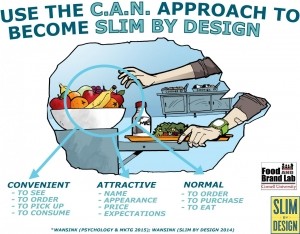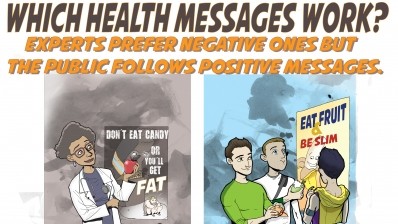Three ways to encourage healthy eating anywhere

Each day the average person makes around 200 food-related decisions, 90% of which involve quick instinctive actions.
For Brian Wansink, director of the Cornell Food and Brand lab, these unconscious snap decisions are an opportunity for food manufacturers, retailers and policy-makers to influence the eating environment so that the instinctive food choices are healthy ones.
Looking at 112 studies on healthy eating and consumer behaviour in schools, restaurants, supermarkets and the home, Wansink identified three key factors which ensured successful healthy eating in all contexts - people were more likely to choose an apple over a doughnut if the apple was visible and easy to reach (convenient), enticingly displayed (attractive) and appeared to be an obvious, popular choice (normal).
"With these three principles, there are endless changes that can be made to lead people -- including ourselves -- to eat healthier," said Wansink who has dubbed the method the CAN approach.
Spurred on by the fact that most research on eating behaviour is rarely taken on board by companies or government, the researcher wanted to provide n easy-to-use framework to apply the findings.
Convenient
The first step - convenience - relates to the way food is offered, and this must be adapted to the target consumer.
In one study, researchers asked children aged 5 to 11 why they did not eat more apples or pears. They replied that the fruit WAs too big for their mouths or that it gOT stuck in their braces; adolescent girls said that it was too messy to eat in front of others. Pre-cut fruit therefore offered a solution to both convenience problems – and resulted in a 70% higher uptake in fruit consumption.
Manufacturers should also reduce the physical and cognitive effort involved in choosing the healthy options - and this could be done in innovative ways.
“Technology—in the form of smart menu boards, personal menu profiles, or simply more stylized information—could greatly alter or guide consumers to new choices by not only making healthier choices more cognitively convenient to make but also making them more convenient to visualize, consider, and ultimately choose,” Wansink wrote.
Attractive
Healthy eating choices must appear more attractive than less healthy alternatives, either in terms of appearance or cost.
For children ‘dinosaur trees’ are more exciting than broccoli florets while a ‘Big Bad Bean Burrito’ is more appetising than a vegetarian burrito.
Furthermore, attractive packaging, descriptive names, colour and labels could have a concrete impact on taste perception: “Attractive and descriptive names not only raise the salience or awareness of the food, but also raise one’s taste expectations."
“The resulting confirmatory sensory bias has led people to “taste what they expect.”
Normal
Finally, healthy choices should appear to be popular among others and normal.
Wansink said that industry was often effective in pro-actively suggesting norms which then altered consumer behaviour.
“Although government’s approach in suggesting norms has often been top-down and prescriptive, industry’s approach of simply changing package sizes (the 100 calorie pack) or packaging (re-sealable bottles) led to new consumption norms and reduced intake, while profitably increasing the price per ounce of these products.”
A crisis of epic proportions
The research comes amid WHO warnings that the obesity crisis in Europe is set to take epic proportions in the next fifteen years.
Dr Joao Breda said: “Action taken today can prevent these predictions from becoming reality and in some European countries the trend is already flattening off thanks to preventive measures including successes, for example in the area of childhood obesity.”
Source: Psychology and Marketing Journal
Vol. 32(5): 486–500 (May 2015) DOI: 10.1002/mar.20794
"Change Their Choice! Changing Behavior Using the CAN Approach and Activism Research"
Author: Brian Wansink




























